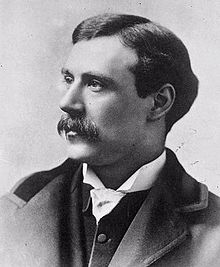William Friese-Greene

William Friese-Greene (born September 7, 1855 in Bristol , † May 8, 1921 in London ; actually William Edward Green ) was a British photographer and inventor .
Life
William Green was introduced to William Green by John Arthur Roebuck Rudge in Bath in 1882 with his series of photographs and "Bio-Phantascope". From 1885 he was the client of Annibal Légé & Co., 31-32 Kirby Street, Hatton-garden, London. He had a machine built for him to perforate strips of paper. Between 1888 and 1889 the engineer Mortimer Evans helped him design a camera for continuous shooting. In 1889 he applied for a patent for a chronophotographic camera with which he was able to record 10 frames per second on paper film, later on roll film . Evans and Green shared English patent no. 10'131, dated June 21, 1889. Evans built a new camera in 1893, British patent 22'954, very similar to the camera used by electrical engineer Frederick Henry Varley 1889-90 Green constructed.
Green only used a simplex camera in 1889. He abandoned the unbearable thought that there should be dark pauses in the representation of a moving image and from then on applied the duplex process . The devices obtained were used to investigate how the exposure of two pictures and film transport could be combined. Long regarded as stereoscopic devices by William Green, the cameras are in fact duplex constructions.
When a bank in which Green was involved went bankrupt, he found himself in prison in 1891.
After his marriage he called himself Friese-Greene, in honor of his wife and with an additional e for the euphony. His son was the cameraman Claude Friese-Greene .
1895-96 began a collaboration Greens with the cinema industrialist John Alfred Prestwich , for whom he designed cameras, a copier and a duplex projector. This is preserved at the Science Museum in London, South Kensington. It is a technically sophisticated device that provides flicker-free projection at any frame rate. The Prestwich cameras, however, are all simplex devices. Green had to accept that he had hit a dead end. Even today, about half of what happened when recording on film is not recorded, depending on the opening angle in the rotating lock .
The life story of Friese-Greene was also the subject of a Ray Allister written biography (1948) and, based on this biopic The Magic Box ( The Magic Box , 1951), in which the creator of Robert Donat was played.
Evans and Green's cameras have been recreated.
literature
- British Kinematograph Society: British Kinematography. London, May 1950; Vol. 16., pp. 156-163. The Place of Friese-Greene in the Invention of Kinematography by R. Howard Cricks.
- Ray Allister: Friese-Greene: Close-up of an Inventor . Special Re-Issue with eight pages of photographs from the 1951 Festival film The Magic Box etc. Marsland, London, 1951, 192 S. So far no German translation, also no English editions of more recent date.
- Herbert Tümmel: From the history of cinematography . In: Kino-Technik , 1956–57.
- CW Ceram : An Archeology of Cinema . Rowohlt, Reinbek near Hamburg 1965.
- Brian Coe: Muybridge and the Chronophotographers. Museum of the Moving Image, London, 1992.
- London Gazette, May 12, 1896.
Web links
- William Friese-Greene in the Internet Movie Database (English)
- Friese-Greene and Evans on theimpossiblecameras.weebly.com (English)
| personal data | |
|---|---|
| SURNAME | Friese-Greene, William |
| ALTERNATIVE NAMES | Green, William Edward (real name) |
| BRIEF DESCRIPTION | British photographer and inventor |
| DATE OF BIRTH | September 7, 1855 |
| PLACE OF BIRTH | Bristol |
| DATE OF DEATH | May 8, 1921 |
| Place of death | London |
